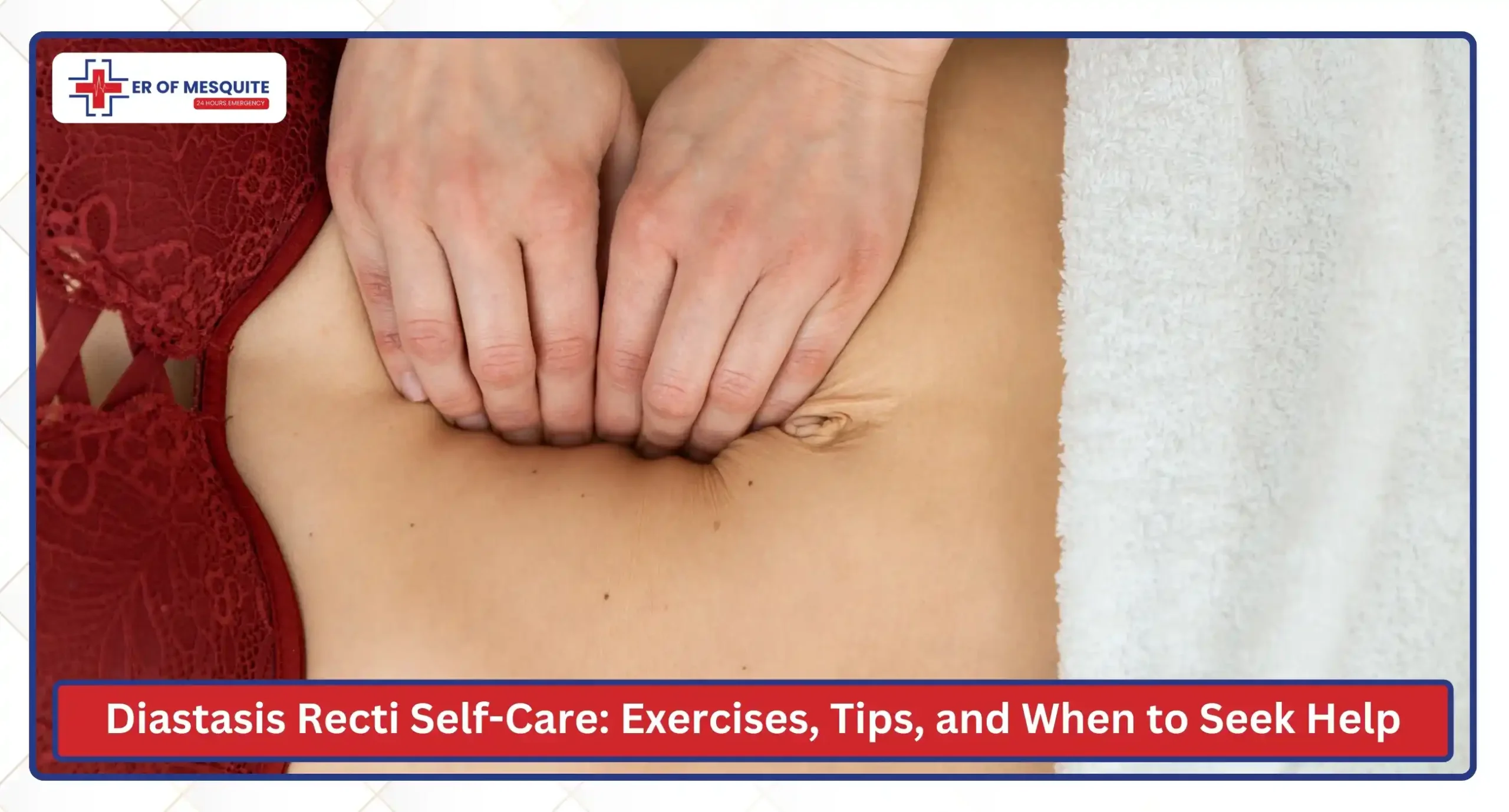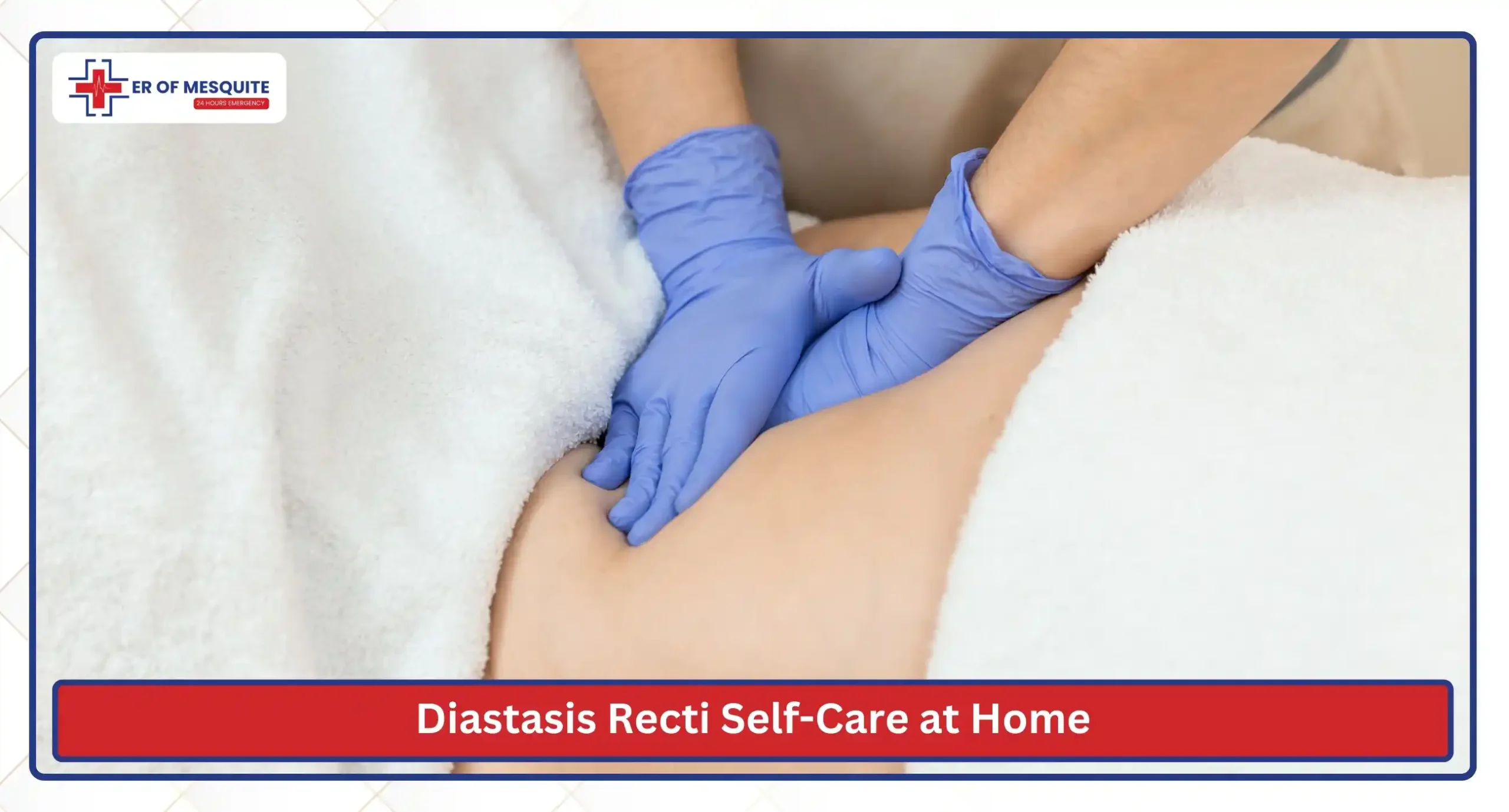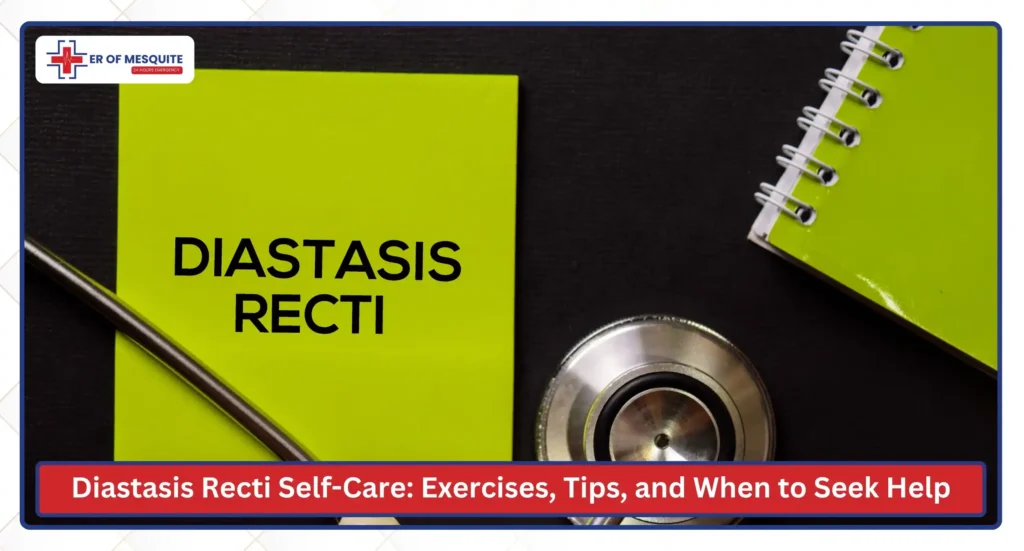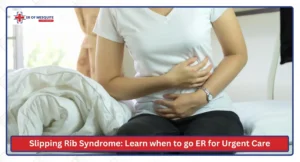If you’ve noticed a persistent bulge in your abdomen after pregnancy or feel weakness in your core, you might be dealing with diastasis recti self-care needs. Diastasis recti, a separation of the abdominal muscles, is common, affecting up to 60% of women postpartum, but it can also impact men and infants.
This guide explores effective diastasis recti self-care at home, including safe exercises, lifestyle tips, and when to seek professional help in Mesquite, TX. From understanding symptoms like a belly “pooch” to learning how to check for diastasis recti, we’ll cover everything you need to manage this condition without invasive measures. For severe cases or complications, the ER of Mesquite offers rapid diagnostics to ensure you get answers fast.
Whether you’re a new mom, an athlete, or someone noticing abdominal changes, self-care can strengthen your core and improve your quality of life. Let’s dive into how you can take control with practical, evidence-based strategies.
What Is Diastasis Recti?

Diastasis recti occurs when the rectus abdominis muscles (the “six-pack” abs) separate along the midline, creating a gap in the abdominal wall. This happens due to stretching of the linea alba, the connective tissue between the muscles. Most common during pregnancy, it can also affect men, infants, or anyone under excessive abdominal strain. The condition may cause a visible bulge, core weakness, or related issues like back pain, but self-care can help close the gap over time.
Diastasis Recti in Infants
In infants, diastasis recti is often congenital, showing as a soft bulge along the abdomen’s midline during crying or straining. It’s typically harmless, caused by immature muscles, and resolves by age 1–2. Parents can support recovery with gentle tummy time (short sessions, 2–3 minutes) to build core strength, but no aggressive interventions are needed. If the bulge persists beyond infancy or is paired with symptoms like feeding issues, a professional evaluation via pediatric care is advised.
Diastasis Recti in Men
Men can develop diastasis recti from chronic straining, such as heavy lifting, obesity, or persistent coughing. Symptoms include a protruding belly and reduced core stability. Self-care involves weight management, proper lifting form, and core exercises, but addressing underlying causes like constipation is key. Severe cases may require medical assessment to rule out complications like hernias.
Symptoms and Causes of Diastasis Recti
Common Symptoms of Diastasis Recti
Diastasis recti presents as a visible bulge or “pooch” above or below the belly button, especially when straining (e.g., sitting up). Other signs include:
- Soft, jelly-like texture around the navel.
- Coning or doming when contracting abs (e.g., leaning back).
- Difficulty with tasks like lifting or walking.
- Lower back pain from weak core support.
- Poor posture due to reduced abdominal strength.
- Digestive issues like bloating or constipation from altered organ support.
What Does Diastasis Recti Feel Like?
The condition itself isn’t painful, but you may feel core instability, like your midsection is “unsupported.” Some describe a gap or softness when pressing the abdomen. Related discomfort, such as lower back pain, may arise from weakened muscles.
Pictures of Severe Diastasis Recti
Severe cases show a pronounced bulge, sometimes resembling a hernia or “bread loaf” shape when straining. The gap may be wider than 2–3 fingers, with loose skin or visible separation. For accurate visuals, consult a provider, as images can vary. Severe cases may signal complications needing urgent evaluation.
Does Diastasis Recti Hurt During Pregnancy?
Diastasis recti itself doesn’t typically cause pain, but associated issues like back strain or pelvic discomfort can. Persistent pain may warrant checking for other conditions, such as those requiring abdominal pain care.
Causes of Diastasis Recti
The primary cause is pregnancy, where hormonal softening and uterine expansion stretch the linea alba. Other causes include:
- Excessive abdominal pressure from heavy lifting, obesity, or high-impact sports.
- Age-related muscle weakening.
- Abdominal surgeries disrupt muscle alignment.
- Genetic predisposition to weaker connective tissue.
- Gender, with women more affected, though men are susceptible to straining.
Risk Factors
Risks include multiple pregnancies, age over 35, delivering large babies, short pregnancy intervals, being petite, or pushing during vaginal delivery. For men, chronic weightlifting or obesity increases risk.
Complications of Diastasis Recti
If ignored, complications may include chronic back pain, pelvic floor dysfunction (e.g., urinary incontinence), hernias, or digestive issues like constipation. These can impact daily life, potentially requiring specialized treatment for relief.
Diagnosis and Tests
How to Check for Diastasis Recti
Healthcare providers diagnose diastasis recti by feeling for a gap during a physical exam, often using ultrasound or calipers for precision. A separation wider than 2 cm (about two fingers) confirms the condition.
Diastasis Recti: How to Check Yourself at Home
To self-check:
- Lie on your back, knees bent, feet flat.
- Place fingers above the belly button, pointing toward toes.
- Lift head slightly (like a mini crunch) and feel for a gap.
- Repeat below and at the navel. A gap of two or more fingers suggests diastasis recti. For confirmation, seek advanced imaging at a facility like the ER of Mesquite.
Diastasis Recti Self-Care at Home

Self-care focuses on strengthening the core safely, improving posture, and adjusting daily habits. Consistency is key for mild to moderate cases.
Diastasis Recti Self-Care Exercises
These exercises target deep abdominal muscles (transverse abdominis) and the pelvic floor without worsening separation. Consult a physical therapist if you’re new to these movements.
- Deep Belly Breathing with Abdominal Contraction: Lie back, inhale deeply to expand belly, exhale while pulling navel toward spine. Hold 5–10 seconds, repeat 10 times. Enhances core-pelvic coordination.
- Pelvic Tilts: On back, tilt pelvis to press lower back into the floor. Hold 5 seconds, 10–15 reps. Strengthens lower abs safely.
- Heel Slides: Slide one heel out, keeping core engaged, alternate. 10 reps per leg. Promotes stability.
- Single Leg Stretch: Lift and extend one leg, keeping the other bent, and switch. 8–10 per side. Targets the deep core.
- Bridging: Lift hips into a bridge, engaging glutes and core. Hold 5 seconds, 10 reps. Builds overall stability.
- Modified Side Plank: From knees, lift into a side plank. Hold 10–20 seconds per side. Strengthens obliques.
Perform daily, starting with 5–10 minutes, and progress slowly.
Diastasis Recti Exercises to Avoid
Avoid movements that increase abdominal pressure or cause bulging/coning, such as:
- Crunches or sit-ups.
- Full planks or push-ups.
- Yoga poses like the downward dog or the boat pose.
- Pilates moves, like double leg lifts. These can worsen separation and delay healing.
Lifestyle Tips for Diastasis Recti Self-Care
- Avoid lifting heavier than 10–15 pounds (postpartum, stick to baby’s weight).
- Roll to the side when rising from bed or a chair.
- Use supportive garments to cue core engagement (not a fix).
- Practice good posture, take deep, rib-expanding breaths.
- Maintain a healthy weight with balanced nutrition to reduce abdominal strain.
How to Heal Diastasis Recti Fast
Healing depends on severity and consistency. Mild cases may improve in 6–8 weeks with dedicated exercises and PT. Avoid aggravating moves, prioritize nutrition for tissue repair (e.g., protein, vitamin C), and consider professional guidance for faster progress. Severe cases may take 6–12 months.
Diastasis Recti During Pregnancy: Self-Care Tips
How to Help Diastasis Recti While Pregnant
To minimize separation:
- Practice safe exercises like pelvic tilts or seated core contractions.
- Wear a maternity support band for comfort.
- Avoid twisting, heavy lifting, or crunches after 12 weeks.
- Maintain an upright posture to reduce strain.
Does Diastasis Recti Hurt During Pregnancy?
No direct pain, but related discomfort, like back or pelvic pain, may occur. Persistent issues may require pelvic pain management.
Treatment Options for Diastasis Recti

Non-Surgical Treatments
Most cases improve with physical therapy, tailored exercise programs, or at-home self-care. Support garments can aid posture, but don’t heal the gap.
Diastasis Recti Surgery
For severe cases or those with hernias, abdominoplasty (tummy tuck) repairs the separation. It’s considered when non-surgical methods fail after 6–12 months.
Can You Fix Diastasis Recti Without Surgery?
Yes, most mild to moderate cases respond to exercises and PT. Consistency is critical.
Will Diastasis Recti Heal on Its Own?
Mild cases may close naturally within 6–8 weeks postpartum, especially with self-care. Severe cases need active intervention.
Is It Too Late to Fix Diastasis Recti?
No, even years postpartum, targeted exercises can reduce the gap and improve function.
How Long Does Diastasis Recti Last?
Recovery varies: mild cases take 6–8 weeks, moderate to severe cases 6–12 months or more. Consistency with exercises and avoiding strain speeds healing.
Can I Get Diastasis Recti Again?
Yes, especially with future pregnancies or straining. Strengthen core pre-pregnancy to lower risk.
Preventing Diastasis Recti
Prevent by:
- Managing pregnancy weight gain (consult provider for healthy range).
- Practicing safe core exercises pre- and post-pregnancy.
- Maintaining good posture and deep breathing.
- Avoiding heavy lifting or straining movements. A 35% reduction in risk is possible with regular, safe core workouts, per studies.
When Should I See My Healthcare Provider?
Seek care if:
- The gap is wider than two fingers after 6–8 weeks.
- You experience persistent pain, digestive issues, or hernia signs (bulge with pressure).
- Daily function is impaired. For urgent symptoms like severe abdominal discomfort, visit the ER of Mesquite for immediate on-site testing.
Frequently Asked Questions
How to Help Diastasis Recti While Pregnant?
Use gentle core exercises (e.g., pelvic tilts), wear support bands, and avoid heavy lifting or twisting.
How to Heal Diastasis Recti Fast?
Consistent self-care exercises, PT, and proper nutrition can show results in 6–8 weeks for mild cases.
Does Diastasis Recti Hurt During Pregnancy?
No, but related or pelvic discomfort may occur, potentially needing medical attention.
What Is Diastasis Recti in Infants?
A temporary midline bulge in newborns usually resolves by age 1–2 without treatment.
How Do I Know If I Suffer from Diastasis Recti?
Self-check for a gap wider than two fingers, confirm with professional rapid diagnostics.
What Happens If You Ignore Diastasis Recti?
It can cause chronic pain, poor posture, hernias, or digestive issues if left unmanaged.
How Long Does Diastasis Recti Take to Go?
Mild stress fractures typically heal in 6–8 weeks, while severe cases may take up to a year with consistent care and effort.
Can Men Get Diastasis Recti?
Yes, stress fractures can result from obesity, heavy lifting, or chronic straining, putting excess pressure on the bones.
Conclusion
In conclusion, diastasis recti self-care empowers you to strengthen your core and reduce abdominal separation through safe exercises and mindful habits. For residents of Mesquite or the DFW area, if symptoms persist or complications like severe pain arise, the ER of Mesquite offers 24/7 emergency care with advanced diagnostics to ensure prompt answers. Contact us today to take the next step toward recovery.





